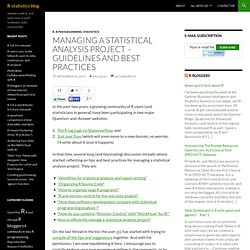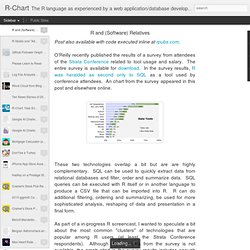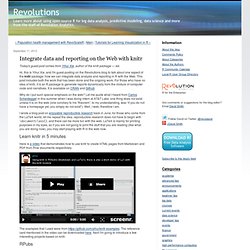

LyX / Tutorials. Managing a statistical analysis project – guidelines and best practices. In the past two years, a growing community of R users (and statisticians in general) have been participating in two major Question-and-Answer websites: In that time, several long (and fascinating) discussion threads where started, reflecting on tips and best practices for managing a statistical analysis project.

They are: On the last thread in the list, the user chl, has started with trying to compile all the tips and suggestions together. And with his permission, I am now republishing it here. I encourage you to contribute from your own experience (either in the comments, or by answering to any of the threads I’ve linked to) From here on is what “chl” wrote: These guidelines where compiled from SO (as suggested by @Shane), Biostar (hereafter, BS), and SE.
Data management Coding Analysis Versioning use some kind of CVS for easy tracking/export, e.g. Editing/Reporting [R] Sweave (Matt Parker /SO)[R] brew (Shane /SO)[R] [R2HTML]20 or ascii. R Studio and "Advanced R Development" Post also available with code executed inline at rpubs.com.

O'Reilly recently published the results of a survey from attendees of the Strata Conference related to tool usage and salary. The entire survey is available for download. In the survey results, R was heralded as second only to SQL as a tool used by conference attendees. An chart from the survey appeared in this post and elsewhere online.
These two technologies overlap a bit but are are highly complementary. As part of a in-progress R screencast, I wanted to speculate a bit about the most common "clusters" of technologies that are popular among R users (at least the Strata Conference respondents). So the first step was to replicate the original plot with a few cosmetic and editorial updates - no "Respodents" appear in the new version. R - How do I prevent exposure of my password when using RGoogleDocs. Using knitr and RWordPress to publish results directly from R. Update: The original source file for this post, generates this output file formatted for wordpress.

The source file has been knitted for markdown formatting so this post displays in Jekyll. The rendered post relies on Wordpress shortcodes, as raw the output file shows above. The markdown-based rendering shows the images and the shortcodes wordpress uses for codeblocks. One of the great things about knitr is its flexibility. Here I set knitr up to publish to Wordpress. I will base the wordpress format on the github-flavored markdown format. Render_gfm() options(width = 30) opts_knit$set(upload = TRUE) knit_hooks$set(output = function(x, options) paste("[code]\n", x, "[/code]\n", sep = ""), source = function(x, options) paste("[code lang='r']\n", x, "[/code]\n", sep = ""), plot = hook_plot_html) Now we write some code chunks in this markdown file: ## a simple calculator 1 + 1 ## boring random numbers set.seed(123) rnorm(5) We can also produce plots which are uploaded to imgur.com: Addendum.
Bioc-devel] Bioconductor coding standards. Git/Github. R code style guide. Integrate data and reporting on the Web with knitr. Today's guest post comes from Yihui Xie, author of the knitr package — ed.

Hi, this is Yihui Xie, and I'm guest posting on the Revolutions blog to talk about one aspect of the knitr package: how we can integrate data analysis and reporting in R with the Web. This post includes both the work that has been done and the ongoing work. For those who have no idea of knitr, it is an R package to generate reports dynamically from the mixture of computer code and narratives.
It is available on CRAN and Github. Why do I put such special emphasis on the web? I wrote a blog post on enjoyable reproducible research back in June; for those who come from the LaTeX world, let me repeat the idea: reproducible research does not have to begin with \documentclass{}, and there can be more fun with the web. Learn knitr in 5 minutes Here is a video that demonstrates how to use knitr to create HTML pages from Markdown and PDF from Rnw documents respectively.
RPubs. Creating Scientific Posters using R, Latex, Beamer and Beamerposter.